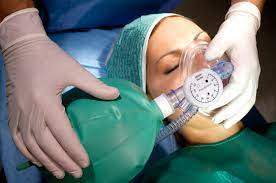Definisi
Gagal napas adalah kondisi ketika paru-paru sulit menyuplai oksigen ke dalam darah dan juga sulit mengeluarkan karbondioksida dari darah. Kondisi ini menyebabkan kadar oksigen tubuh menurun, sedangkan kadar karbondioksida meningkat. Rendahnya kadar oksigen di dalam tubuh akan mengganggu fungsi organ-organ tubuh.
Kondisi ketika tidak terdapat cukup oksigen di dalam darah disebut dengan hipoksemia atau gagal napas tipe 1. Sementara, jika terlalu banyak karbondioksida dalam darah, disebut dengan hiperkapnia, hiperkarbia, atau gagal napas tipe 2.
Gagal napas akut terjadi dengan cepat dan bersifat darurat. Namun, gagal napas juga bisa menjadi kronis, yaitu berlangsung dalam jangka panjang, dan perlu penanganan khusus untuk mengelolanya.
Penyebab
Meski terlihat sederhana, bernapas melibatkan banyak bagian tubuh. Masalah pada salah satu bagian tubuh tersebut dapat menyebabkan gagal napas, antara lain:
- Cedera dada atau tulang rusuk
- Overdosis obat atau alkohol, dapat mengganggu otak yang mengontrol pernapasan
- Kerusakan paru akibat menghirup asap atau polusi
- Penyakit atau infeksi paru seperti penyakit paru obstruktif kronik (PPOK), cystic fibrosis, atau pneumonia (radang paru)
- Kerusakan otot dan saraf yang berperan pada pernapasan akibat penyakit tertentu seperti amyotrophic lateral sclerosis (ALS), cedera tulang belakang, atau stroke
- Skoliosis atau masalah tulang belakang lainnya, dapat mempengaruhi tulang dan otot yang terlibat dalam pernapasan
- Sumbatan aliran darah ke paru, misalnya karena bekuan darah
Gagal napas akut lebih sering terjadi karena cedera otak, dada, atau paru-paru. Kondisi seperti tersedak, tenggelam, atau tertembak di area dada dapat menimbulkan gagal napas akut. Dengan waktu yang cepat, penyakit pernapasan serius, seperti sindrom gangguan pernapasan akut (ARDS), juga dapat menyebabkan gagal napas akut.
Faktor Risiko
Anda akan lebih berisiko mengalami gagal napas jika:
- Memiliki penyakit pernapasan jangka panjang seperti PPOK atau asma
- Merokok
- Penyalahgunaan alkohol
- Memiliki riwayat keluarga dengan masalah pernapasan
Gejala
Gejala gagal napas bervariasi tergantung pada penyebab dan kondisi hipoksemia atau hiperkapnia yang Anda alami. Beberapa hal yang perlu diperhatikan sebagai tanda dan gejala gagal napas adalah:
- Warna kebiruan pada kuku, bibir, dan kulit
- Merasa tidak bisa menghirup udara dengan cukup
- Kebingungan
- Detak jantung menghilang
- Bernapas dengan cepat atau sangat lambat
- Bernapas dengan tersengal
- Mengantuk atau pingsan
Diagnosis
Dokter akan mulai mendiagnosis dengan menanyakan keluhan dan riwayat kesehatan Anda, lalu melakukan pemeriksaan fisik. Setelah itu, dokter akan melakukan atau merekomendasikan beberapa tes berikut:
- Oksimetri pulsasi. Dokter meletakkan alat kecil di jari untuk mengukur kadar oksigen dalam darah
- Tes gas darah arteri. Tes ini mengukur kadar oksigen dan karbon dioksida dalam tubuh
- Rontgen dada, untuk melihat kelainan pada rongga dada
- Elektrokardiogram atau EKG, untuk mengukur sinyal listrik jantung
Tata laksana
Penanganan gagal napas antara lain:
Terapi oksigen
Asupan oksigen dapat diberikan melalui masker atau selang hidung. Tersedia tabung oksigen kecil yang lebih mudah untuk dibawa jika perlu berpindah tempat.
Ventilator
Jika terapi oksigen tidak cukup membantu, diperlukan mesin bantu napas atau ventilator. Alat ini meniupkan oksigen ke paru-paru sehingga tubuh mendapatkan oksigen yang dibutuhkan dengan mudah. Ventilator juga membantu menurunkan kadar karbon dioksida.
Ada beberapa jenis ventilator. Yang paling sederhana disambungkan dengan masker oksigen yang menutupi hidung dan mulut. Salah satu contoh alat bantu napas sederhana adalah CPAP yang digunakan untuk menangani sleep apnea atau berhentinya napas beberapa saat ketika tidur.
Pada kasus yang lebih berat, diperlukan selang pernapasan yang dimasukan langsung ke tenggorokan dan dihubungkan ke ventilator.
Trakeostomi
Trakeostomi adalah operasi pembuatan lubang di leher untuk memasukan tabung kecil ke dalam tenggorokan sebagai jalur masuk udara. Tabung tersebut akan mempermudah pernapasan pasien. Tabung tenggorokan juga diperlukan jika pasien membutuhkan ventilator selama lebih dari 1 atau 2 minggu. Tabung tenggorokan akan langsung tersambung dengan ventilator.
Mengobati penyebab
Berikut beberapa pengobatan dari penyebab gagal napas :
- Antibiotik untuk mengobati pneumonia atau infeksi paru
- Obat penghancur gumpalan darah
- Obat yang dihirup untuk membuka saluran udara
- Selang dada untuk mengalirkan darah atau udara yang menumpuk di paru pada kasus cedera
Pengobatan gagal napas bergantung pada penyebabnya dan apakah bersifat kronis atau akut. Gagal napas bersifat akut jika muncul tiba-tiba dan baru saja terjadi. Sedangkan, bersifat kronis jika sudah berlangsung dalam jangka lama.
Pada gagal napas akut, pasien harus segera ditangani di unit gawat darurat (UGD). Namun, jika penanganan di UGD tidak berhasil, pasien perlu dirawat inap di rumah sakit. Untuk kasus yang berat, mungkin diperlukan penanganan di unit perawatan intensif (ICU). Pasien akan mendapatkan terapi oksigen, memerlukan ventilator sampai bisa bernapas sendiri, mendapat obat-obatan dan cairan untuk meredakan gejala, serta mengobati penyebab gagal napas.
Pada gagal napas kronis, pasien akan mendapatkan perawatan berkelanjutan di rumah, yang biasanya mencakup obat-obatan rutin baik dalam bentuk obat hirup atau obat yang diminum. Pada kasus yang berat, pasien mungkin memerlukan terapi oksigen.
Karena gagal napas dapat mengganggu tidur, pasien juga membutuhkan bantuan lebih di malam hari seperti menggunakan ventilator kecil untuk memasukkan lebih banyak oksigen ke paru. Atau pasien dapat menggunakan tempat tidur goyang khusus untuk membantunya bernapas dengan lebih baik. Pada kasus yang lebih serius, pasien memerlukan ventilator.
Komplikasi
Seringkali tidak ada obat untuk gagal napas kronis. Namun, gejalanya dapat dikelola dengan pengobatan. Jika Anda memiliki penyakit paru-paru jangka panjang, seperti PPOK atau emfisema, Anda mungkin memerlukan bantuan napas terus-menerus. Perkembangan kondisi Anda tergantung pada penyebab gagal napas, kesehatan Anda secara keseluruhan, dan seberapa cepat Anda mendapatkan penanganan.
Komplikasi dari gagal napas dapat disebabkan oleh gangguan gas darah atau karena efek samping dari pengobatan. Beberapa komplikasi gagal napas berdasarkan organ yang terkena antara lain:
- Komplikasi paru, seperti emboli paru (sumbatan pembuluh darah paru), terbentuk jaringan parut pada paru, pneumotoraks (penumpukan udara di pembungkus paru), dan ketergantungan pada ventilator
- Komplikasi jantung, misalnya, aritmia (detak jantung tidak teratur), gagal jantung, henti jantung, dan infark miokard akut (serangan jantung)
- Komplikasi saraf seperti kondisi kekurangan oksigen jangka panjang pada otak dapat menyebabkan sel otak rusak hingga mati
- Komplikasi ginjal meliputi gagal ginjal akut karena kekurangan oksigen atau efek samping dari obat tertentu
- Komplikasi pencernaan meliputi stress ulcer, gangguan gerakan usus, dan pendarahan
- Komplikasi nutrisi meliputi malnutrisi, diare hipoglikemia, gangguan elektrolit
- Infeksi meliputi sepsis, yaitu infeksi luas yang menyebar melalui aliran darah. Komplikasi ini termasuk penyebab kematian tersering pada gagal napas akut
- Kematian karena kegagalan multiorgan
Pencegahan
Jika Anda memiliki kondisi lain yang meningkatkan risiko gagal napas, sangat penting untuk mengikuti rencana penanganan dari dokter. Beberapa hal yang dapat Anda lakukan untuk menjaga paru-paru tetap sehat adalah berhenti atau tidak merokok sama sekali, mengurangi konsumsi alkohol, serta tidak mengkonsumsi obat-obatan terlarang.
Dokter juga akan menyarankan pola hidup sehat seperti menjadi lebih aktif, diet sesuai dengan kondisi tubuh dan penyakit penyerta, mencapai berat badan ideal, mengelola stres, dan cukup tidur. Pola hidup sehat akan mengurangi risiko Anda mengalami gagal napas.
Kapan harus ke dokter?
Jika mengalami tanda dan gejala gagal napas seperti yang disebutkan di atas, segera hubungi nomor telepon darurat atau cari bantuan ke unit gawat darurat.
Jika Anda memiliki kondisi yang meningkatkan risiko gagal napas, konsultasikan hal tersebut pada dokter untuk mencegah kondisi yang lebih berat.
Dokter akan mengajukan pertanyaan dan melakukan pemeriksaan fisik untuk mencari masalah yang membuat Anda berisiko mengalami gangguan pernapasan di masa mendatang. Dokter akan memberitahu Anda cara mengelola kesehatan untuk mencegah gagal napas.
- dr Anita Larasati Priyono
Moore W. (2021). Respiratory failure. Retrieved 25 February 2022, from https://www.webmd.com/lung/acute-chronic-respiratory-failure
Kahn A. (2018). Chronic respiratory failure. Retrieved 25 February 2022, from https://www.healthline.com/health/chronic-respiratory-failure
Kaynar AM. (2020). Respiratory failure. Retrieved 25 February 2022, from https://emedicine.medscape.com/article/167981-overview
Respiratory failure. (2020). Retrieved 25 February 2022, from https://medlineplus.gov/respiratoryfailure.html#:~:text=Respiratory%20failure%20is%20a%20condition,carries%20it%20to%20your%20organs.
Shebl E, Burns B. (2021). Respiratory Failure. Retrieved 25 February 2022, from https://www.ncbi.nlm.nih.gov/books/NBK526127/
Respiratory failure. (2018). Retrieved 25 February 2022, from https://www.nhlbi.nih.gov/health-topics/respiratory-failure











